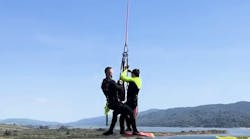March 31, 2023 – Detroit, Michigan: The Slate Corporation has announced release of a new, fully autonomous, hybrid fuel vehicle designed and equipped for law enforcement / peace promotion services in urban areas. They call this vehicle the Pod Observing Life In Cities Everywhere, or “POLICE” for short. The Slate POLICE vehicle beta version has been deployed in 12 cities in Europe over the past year and with feedback from those law enforcement agencies, Slate has incorporated upgrades to insure the POLICE vehicle performs to the expected standards in the United States.
In her statement about the development of the POLICE vehicle, President and CEO of Slate Corp., Nelos Muk said, “In today’s world, we recognize that the American public expects a law enforcement experience that offers compassion and de-escalation as necessary for humanity. The standards we used in developing the final version of the pod included performance as well as equipment and a combination of the firmware slash software.”
That combination of equipment and firmware/software provides for a patrol vehicle that can observe conditions and behaviors in any weather environment for a maximum of 14 hours before it need to be recharged. The vehicle itself is powered by a hybrid engine, mounted in the center of the pod which provides for greater handling stability if the pod needs to operate in uneven terrain or under pursuit conditions. The hybrid engine is electric and internal combustion and provides for battery recharge through two sources: The internal combustion component, when running, provides a charge to the battery. There is also 600W worth of solar panels built into the skin of the pod providing an on-going charge to the battery provided there is adequate sunlight. The battery alone will power all features on the pod for up to eight hours, but the recharge provided by the gasoline engine and the solar power system can extend that eight hours to between 16-20 hours depending on conditions and services demand.
The POLICE vehicle looks radically different from any previous law enforcement patrol vehicle. It is circular in shape and resembles, effectively, half of a huge ball. The paint scheme is traditional black and white as you’d expect from a patrol vehicle. Separating the white top half from the black lower half is a thin blue line representing the law enforcement family. Closer to the top of the vehicle is a dual level LED lightbar. The bottom bar emits white light in all directions, dependent on the time of day and light level available naturally. The dimmest setting on the lightbar is 100 lumens with the highest setting providing 2,500 lumens. The programming for the white light bar is such that parts of the bar can be made brighter than others as necessary to support the 360° camera system. The second, placed higher, lightbar is programmed to show flashing yellow lights in segments all the way around the vehicle, but dependent on need, can flash blue or red when in emergency mode.
“The POLICE pod is designed to add visibility, observation, intercession and emergency alert services,” said CEO Muk. “The cameras operate anytime the vehicle is activated or ‘on duty,’ and the images they capture are filtered through a system that recognizes dangerous conditions or items, such as vehicle accidents or weapons. If those things are observed, an alert is sent via data-burst back to the agency’s emergency dispatch center so the closest law enforcement unit can be dispatched.”
Should there be an emergency circumstance that requires immediate intervention, such as an assault in progress, the POLICE pod is equipped with several non-lethal tools to include Pepper Spray tubes, Pepper ball launchers, a sonic impairment system, electro-muscular disruptor devices and two others that CEO Muk said were “classified per the purchasing agency’s request.” The POLICE Pod can use it’s camera system and on-board radar to determine direction and height of a specific target, adjust the aim of a given non-lethal tool, and engaging the target only if all prerequisites for such use of force are met. To determine whether or not the use of force is lawful, the software system compared the documented circumstances and conditions to the existing statutes and only receives an “engage” or “fire” authorization if 100% of the legal conditions are met.
The final, and perhaps most impressive feature of the POLICE pod is the propulsion system. Like all other contemporary patrol vehicles it has four wheels and tires but each is connected to its own independent suspension unit as well as an independent transmission. What this means is that the software control can move the POLICE pod in any given direction without having to “turn.” There is no front or back on the POLICE pod. For the unit to change direction, as an example, from moving directly north to moving directly west at a cross street, the control computer simply directs the four wheels to change direction, turning them on their connectors 90 degrees in concert. The suspension absorbs the inertia of the pod while the turn is made, but due to the low center of gravity, such directional changes can be made at the pod’s highest speed of 115 mph. CEO Muk noted that the “average patrol speed” for the POLICE pod is 25-35 mph but is determined by the control computer and adjusted constantly.
“We wish we could build some type of emergency first-aid or trauma care into the pod unit,” said Muk, “but the technology necessary for articulated arms just isn’t there yet. Our best solution was to enable the pod to ‘see’ injuries, analyze the risk to those injured, and automatically dispatch fire and EMS units via a link to the dispatch center.”
The POLICE pods are bullet resistant, with armor incorporated into the body of sufficient rating to stop rounds up to and including .50 caliber. The computer control module, located near the center of the pod, is fully armored and is commonly referred to among Slate engineers as “the black box.” It has been tested to withstand the equivalent force of being struck by a 55,000 pound vehicle traveling 80 mph.
The published cost for one fully equipped POLICE vehicle is just under $20,000 which means two or three of them could be purchased for the price of one normal law enforcement patrol unit. That cost offset can be leveraged to put several POLICE pods into service, increasing both law enforcement visibility, the deterrence of a police presence and audio/video surveillance performed in real time and fed back to the emergency communications center for action.
For more information visit… Wait. This is a fictional product created by a fictional company for the purposes of entertainment on April Fools Day!! We hope you enjoyed the read!




